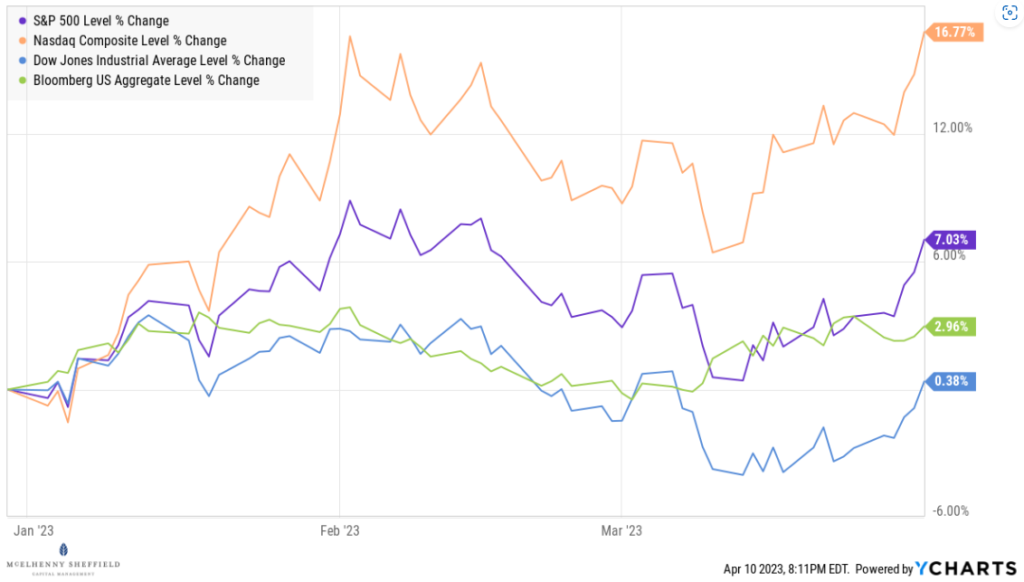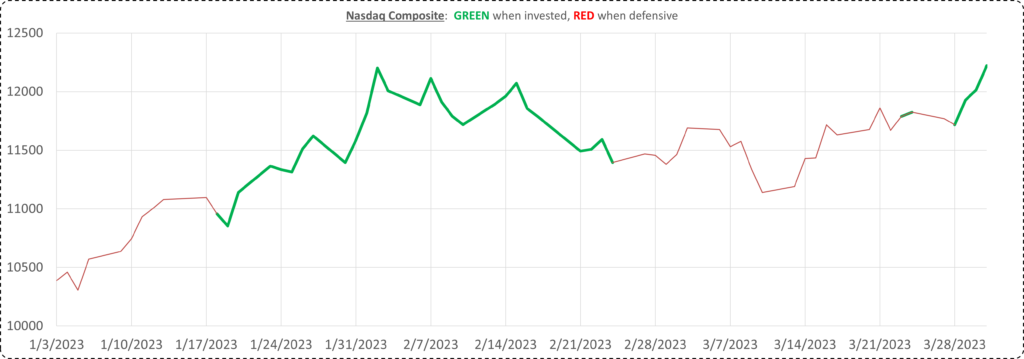Results, as of March 31, 2023
Making money in bear markets.
Our strategies delivered positive returns during the 1st quarter and, while we are happy to make money during bear markets, we’ll continue to invest cautiously and always with a focus on risk management and downside protection.
The bear market that started in 2022 has not ended, even though the first quarter of 2023 saw market strength and a second consecutive quarter of gains in the S&P 500.
- The S&P 500 rose 7% during first quarter, after finishing last year down 19.44%.
- The Nasdaq rose nearly 17% during the first quarter but is still 24% below all-time highs.
- The Dow rose only 0.38% during Q1 and the US bond index rose almost 3%.
- A traditional allocation of 60% stocks and 40% bonds was up approximately 5.5%.

The Fed increased interest rates two times by 25bps each during the first quarter, in its continued attempt to attack inflation. The likelihood of a soft landing in the economy wanes as inflation stays persistently high and more rate increases are needed to achieve the Fed’s long-term inflation goal of 2%. The next report of CPI will be released on April 12th (March data) and the Fed’s next FOMC meeting concludes on May 3rd.
A recession is a big risk to the stock market recovery as corporate earnings estimates would be revised lower on expected declines in revenue and profit margins. This could be the driver for another leg down in the stock market and could lead to the bottom of this bear market.
Regardless of whether a hard or soft landing occurs, our strategies can adjust to market conditions to take the guesswork out of investing. If the market continues to meander higher, we’ll participate as much as possible while adhering to our risk management rules. If the market sells off in anticipation of a recession, our predefined exit points will move us defensive to protect client capital.
Models
TREND PLUS
The Trend Plus strategy was up 3.3% during the quarter and, after losing much less than the broad market and traditional 60/40 allocations during 2022, does not require as large of a return to fully recover and begin making new investment gains for clients.
The strategy participated in a positive uptrend in January and also at the end of March. The graph below shows the times at which Trend Plus was invested in the market (green) versus positioned defensively (red). The strategy remains invested in the uptrend that started late March.

SECTOR ROTATION
The Sector Rotation momentum strategy was up 1% during first quarter, on the heels of being up 1.4% during the fourth quarter of 2022.
The strategy began the year in defensive positions but re-allocated to equity ETFs when our Macro Monitor sell signal turned off in February. Sector Rotation moved partially into aerospace & defense, industrials, and materials at that time, while maintaining some exposure to defensive positions of gold, US dollar, and short-term US treasuries. The materials position stopped out in mid-March and industrials delivered a loss in the quarter, but positive overall results were driven by gains in aerospace & defense and gold.
The strategy is now fully allocated in equity positions for the 2nd quarter in communications, technology, and consumer discretionary, with individual stop levels being monitored daily in case of weakness in any one of these sectors or if there is deterioration in the broad market.
TPSR (50% Trend Plus & 50% Sector Rotation)
The TPSR strategy was up 2.1% during the quarter with positive results in both component strategies. This blended strategy has the ability to be reactive to changing market conditions and will participate nicely if the market rebound continues, while still focusing on moves defensive to protect client capital if the bear market worsens.
Summary
It is great when we are able to achieve positive returns for a quarter in the midst of a bear market, but what is more important for our investors will be the downside protection that our tactical approach offers if the bear market gets worse.
We feel strongly that all investors should have an allocation to tactical strategies such as ours to improve their overall portfolio performance and make it through bear markets more successfully. Please contact us if you have any questions about our strategies or how MSCM can play an important part in your investment management plan.
Our strategy sheets are accessible through the buttons below, and on our website mscm.net.

McElhenny Sheffield Capital Management, 4701 W. Lovers Lane, Dallas, Texas 75209, 214.922.9200

